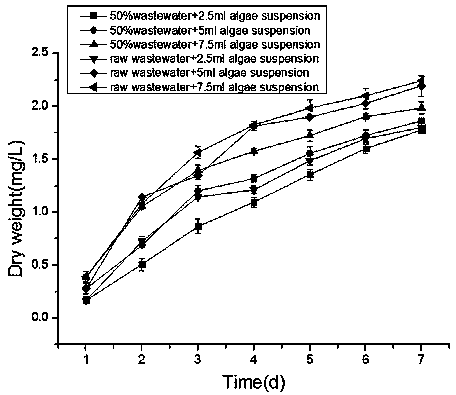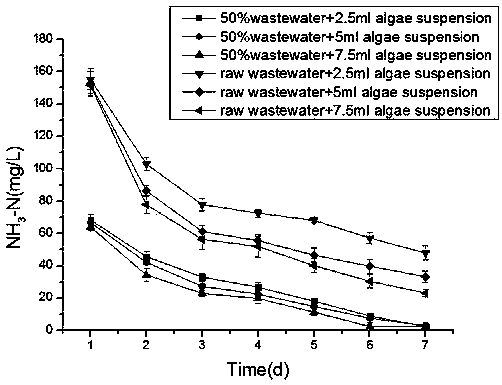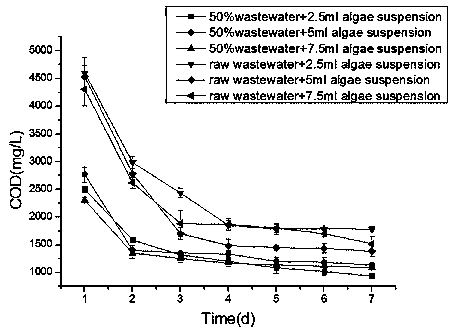Method for processing soy sauce wastewater through microalgae
A waste water and microalgae technology, which is applied in the direction of microorganism-based methods, chemical instruments and methods, and food industry waste water treatment, can solve the problems of non-recycled resources, high treatment costs, and large equipment investment, and achieve high comprehensive utilization , increase economic benefits, the effect of small equipment investment
- Summary
- Abstract
- Description
- Claims
- Application Information
AI Technical Summary
Problems solved by technology
Method used
Image
Examples
Embodiment 1
[0038] Salt-tolerant and pollution-tolerant algal strains—Chlorella pyrenoidosa were isolated and screened in the local water environment. The algal strains can grow autotrophically under photosynthesis, and use organic carbon for heterotrophic growth. At the same time, they can grow under light conditions for simultaneous growth. Its adaptability and growth characteristics in soy sauce wastewater are as follows: figure 1 shown.
[0039] The autotrophic medium formula involved in the above-mentioned microalgae cultivation is: K 2 HPO 4 ·3H 2 O0.04g / L, MgSO 4 ·7H 2 O0.075g / L, CaCl 2 2H 2 O0.036g / L, citric acid 0.006g / L, ferric ammonium citrate 0.006g / L, EDTA 0.001g / L, NaNO 3 1.5g / L, Na 2 CO 3 0.02g / L, A 5 Trace element solution 1.5ml / L, of which A 5 Trace element solution composition: H 3 BO 3 2.86g / L, MnCl 2 4H 2 O1.81g / L, ZnSO 4 ·7H 2 O0.222g / L, NaMoO 4 2H 2 O0.39g / L, CuSO 4 ·5H 2 O 0.079g / L, CoCl 2 ·6H 2 O0.05g / L.
[0040] The formula of the heterotr...
Embodiment 2
[0044] Salt-tolerant and pollution-tolerant algal strains—Spirulina ( Spirulina ) was obtained from early isolation and purification in the laboratory. The algae strain can also adapt to the high concentration of organic matter in soy sauce wastewater. Its adaptability and growth characteristics in soy sauce wastewater are as follows: Figure 6 shown.
[0045] The medium formula involved in the above-mentioned microalgae cultivation is: NaHCO 3 16.8g / L, NaNO 3 2.5g / L, NaCl1.0g / L, K 2 HPO 4 0.5g / L, K 2 SO 4 1.0g / L, MgSO 4 ·7H 2 O0.2g / L, CaCl 2 2H 2 O0.04g / L, EDTA0.08g / L, A 5 Trace elements 1ml / L, B 6 Trace elements 1ml / L. where A 5 Trace element solution composition: H 3 BO 3 2.86g / L, MnCl 2 4H 2 O1.81g / L, ZnSO 4 ·7H 2 O0.222g / L, NaMoO 4 2H 2 O0.39g / L, CuSO 4 ·5H 2 O 0.079g / L, CoCl 2 ·6H 2 O0.05g / L; B 6 Composition of trace element solution: NH 4 VO 3 22.9mg / L, CrK(SO 4 ) 2 12H 2 O 96.0mg / L, NiSO 4 ·6H 2 O47.8mg / L, NaWO 4 2H 2 O17.9mg / L, Co...
PUM
 Login to View More
Login to View More Abstract
Description
Claims
Application Information
 Login to View More
Login to View More - R&D
- Intellectual Property
- Life Sciences
- Materials
- Tech Scout
- Unparalleled Data Quality
- Higher Quality Content
- 60% Fewer Hallucinations
Browse by: Latest US Patents, China's latest patents, Technical Efficacy Thesaurus, Application Domain, Technology Topic, Popular Technical Reports.
© 2025 PatSnap. All rights reserved.Legal|Privacy policy|Modern Slavery Act Transparency Statement|Sitemap|About US| Contact US: help@patsnap.com



